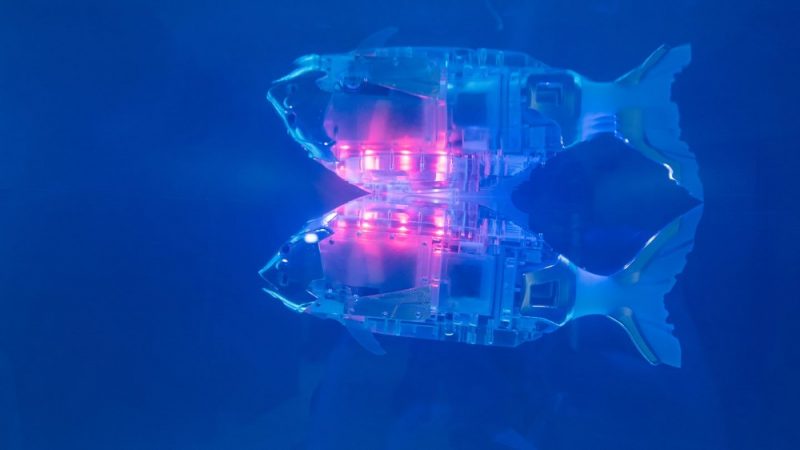Get ready for the robotic fish revolution

This article was originally featured on Hakai Magazine, an online publication about science and society in coastal ecosystems. Read more stories like this at hakaimagazine.com.
Human technology has long drawn inspiration from the natural world: The first airplanes were modeled after birds. The designer of Velcro was inspired by the irksome burrs he often had to pick off his dog. And in recent years, engineers eager to explore the world’s oceans have been taking cues from the creatures that do it best: fish.
Around the world, researchers developing robots that look and swim like fish say their aquatic automatons are cheaper, easier to use, and less disruptive to sea life than the remotely operated vehicles (ROVs) scientists use today. In a recent review of the technology’s advances, scientists claim only a few technical problems stand in the way of a robotic fish revolution.
Over the past few decades, engineers have designed prototype robotic fish for a variety of purposes. While some are built to carry out specific tasks—such as tricking other fish in a lab, simulating fish hydrodynamics, or gathering plastics from the ocean—the majority are designed to traverse the seas while collecting data. These robotic explorers are typically equipped with video cameras to document any life forms they encounter and sensors to measure depth, temperature, and acidity. Some of these machines—including a robotic catfish named Charlie, developed by the CIA—can even take and store water samples.
While modern ROVs can already do all these tasks and more, the review’s authors argue that robotic fish will be the tools of the future.
“The jobs done by existing [ROVs] can be done by robotic fish,” says Weicheng Cui, a marine engineer at Westlake University in China and a coauthor of the review. And “what cannot be done by existing ROVs may [also] be done by robotic fish.”
Since the invention of the first tethered ROV in 1953—a contraption named Poodle—scientists have increasingly relied on ROVs to help them reach parts of the ocean that are too deep or dangerous for scuba divers. ROVs can go to depths that divers can’t reach, spend a virtually unlimited amount of time there, and bring back specimens, both living and not, from their trips.
While ROVs have been a boon for science, most models are large and expensive. The ROVs used by scientific organizations, such as the Monterey Bay Aquarium Research Institute (MBARI), the Woods Hole Oceanographic Institution, the Schmidt Ocean Institute, and OceanX, can weigh nearly as much as a rhinoceros and cost millions of dollars. Such large, high-end ROVs also require a crane to deploy and must be tethered to a mother ship while in the water.
In contrast, robotic fish are battery-powered bots that typically weigh only a few kilograms and cost a couple thousand dollars. Although some have been designed to resemble real fish, robotic fish typically come in neutral colors and resemble their biological counterparts in shape only. Yet, according to Tsam Lung You, an engineer at the University of Bristol in England who was not involved in the review, even the most unrealistic robot fish are less disruptive to aquatic life than the average ROV.
Unlike most ROVs that use propellers to get around, robotic fish swim like the animals that inspired them. Flexing their tails back and forth, robotic fish glide through the water quietly and don’t seem to disturb the surrounding marine life—an advantage for researchers looking to study underwater organisms in their natural environments.
Because robotic fish are small and stealthy, scientists may be able to use them to observe sensitive species or venture into the nooks and crannies of coral reefs, lava tubes, and undersea caves. Although robotic fish are highly maneuverable, current models have one big downside: their range is very limited. With no mother ship to supply them with power and limited room to hold batteries, today’s robotic fish can only spend a few hours in the water at a time.
For robotic fish to make modern ROVs obsolete, they’ll need a key piece that’s currently missing: a docking station where they can autonomously recharge their batteries. Cui envisions a future where schools of small robotic fish work together to accomplish big tasks and take turns docking at underwater charging stations powered by a renewable energy source, like wave power.
“Instead of one [ROV], we can use many robotic fish,” Cui says. “This will greatly increase the efficiency of deep-sea operations.”
This potential future relies on the development of autonomous underwater charging stations, but Cui and his colleagues believe these can be built using existing technologies. The potential docking station’s core, he says, would likely be a wireless charging system. Cui says this fishy future could come to fruition in under a decade if the demand is great enough.
Still, getting scientists to trade in their ROVs for schools of robotic fish may be a tough sell, says Paul Clarkson, the director of husbandry operations at the Monterey Bay Aquarium in California.
“For decades, we’ve benefited from using the remotely operated vehicles designed and operated by our research and technology partner, MBARI,” says Clarkson. “Their ROVs are an essential part of our work and research, and the capabilities they provide make them an irreplaceable tool.”
That said, he adds, “with the threats of climate change, habitat destruction, overfishing, and plastic pollution, we need to consider what advantages new innovations may offer in understanding our changing world.”
This article first appeared in Hakai Magazine and is republished here with permission.










